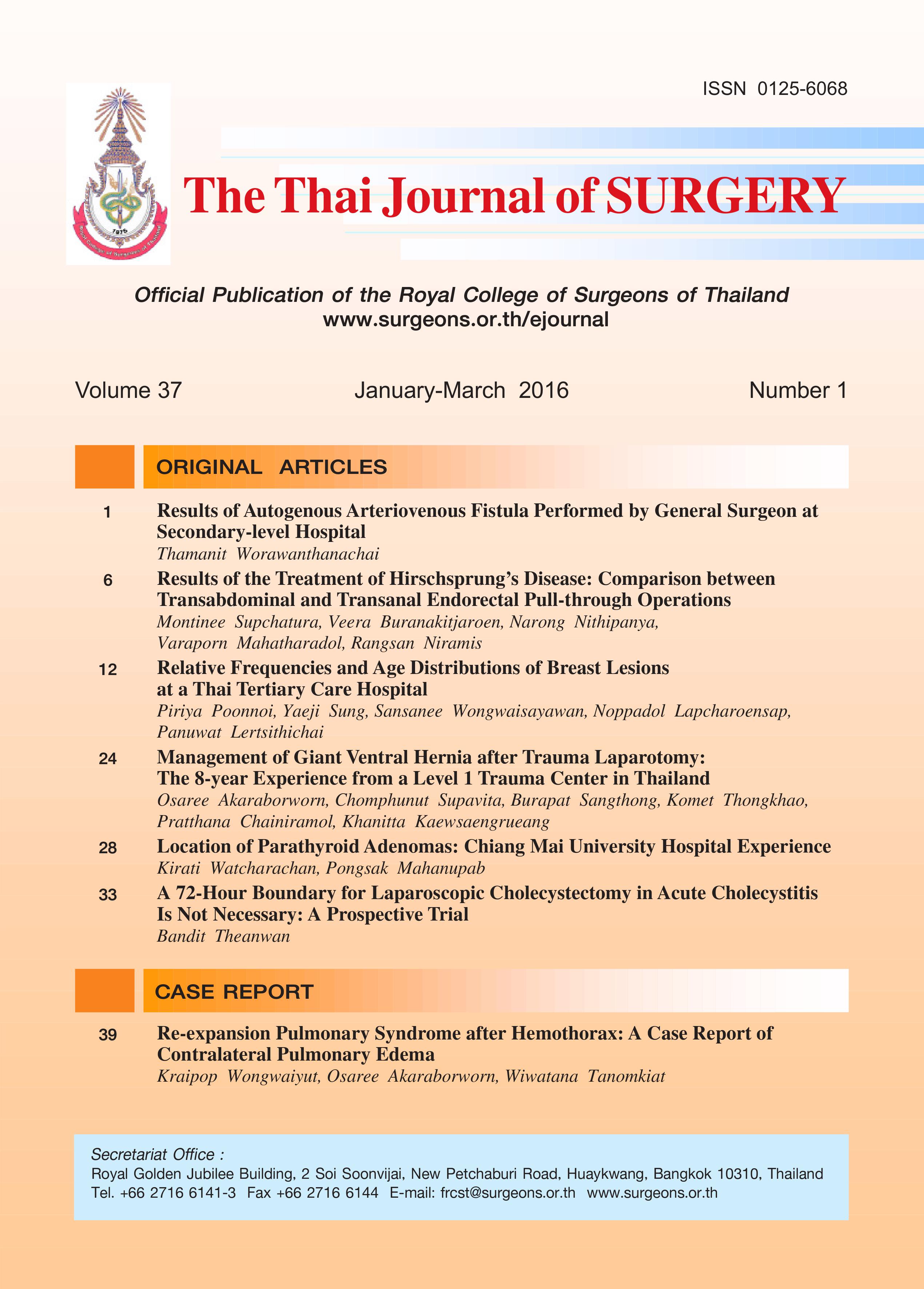Relative Frequencies and Age Distributions of Breast Lesions at a Thai Tertiary Care Hospital
Keywords:
Age distribution, breast lesions, pathology, benign, malignantAbstract
Background and Objectives: To determine the relative frequencies and age distributions of various benign and malignant breast lesions at a Thai tertiary care hospital.
Material and Methods: Patients who consulted for breast problems at Ramathibodi Hospital during the years 2000 and 2010, and who underwent tissue biopsy or surgical excision were included. Pathological data were retrieved from a patient data base using appropriate codes corresponding to SNOMed (Systematized Nomenclature in Medicine) terminology. Breast lesions were the primary units of analysis. Relative frequencies of breast lesions were calculated and age distributions determined.
Results: We included 12,376 lesions. Patients commonly consult and undergo tissue diagnosis for breast lesions during the 2nd and 3rd decades of life, and then again during the 4th and 6th decades, resulting in a bimodal age distribution for both men and women. The most common benign condition in men was hypertrophy, i.e., gynecomastia, for all age groups. The most common benign lesion in women was fibroadenoma, predominantly in the 2nd and 3rd decades of life but continued to be a major finding till the 6th decade. For men with breast cancer, both ductal carcinomas and breast sarcomas were equally common. For women, invasive ductal carcinoma was the most common cancer for all age groups, but breast sarcomas were relatively common during the 2nd and 3rdrd decades of life. For older patients invasive ductal carcinoma was overwhelmingly dominant (> 90% of all invasive cancers). Breast sarcomas accounted for 3% of all invasive cancers in women, if malignant phyllodes tumors were included as well. Thai women with breast cancer were likely younger on average than their Western counterparts.
Conclusion: The pattern of age distribution for histologically diagnosed breast lesions was found to be similar for both men and women. Breast sarcomas were conspicuously more common in the present study than those previously reported. Otherwise most breast lesions, especially in women, were distributed according to age in a similar manner as reported elsewhere.
References
2. Ferlay J, Shin HR, Bray F, et al. Estimates of worldwide burden of cancer in 2008: GLOBOCAN 2008. Int J Cancer 2010;127: 2893-917.
3. Weaver D L, Rosenberg RD, Barlow WE, et al. Pathologic findings from the breast cancer surveillance consortium. Cancer 2006;106:732-42.
4. Pinder SE, Mulligan AM, O’Malley FP. Fibroepithelial lesions including fibroadenoma and phyllodes tumors. In: O’Malley FP, Pinder SE, Mulligan AM, editors. Breast pathology. 2nd ed. Philadelphia: Elsevier-Saunders; 2011. p. 121-38.
5. Schuerch C, Rosen PP, Teruyuki H, et al. A pathologic study of benign breast diseases in Tokyo and New York. Cancer 1982;50;1899-903.
6. Braunstein GD. Gynecomastia. N Engl J Med 2007;357:1229-37.
7. Badve S. Diseases of the male breast. In: O’Malley FP, Pinder SE, Mulligan AM, editors. Breast pathology. 2nd ed. Philadelphia: Elsevier-Saunders; 2011:342-51.
8. Martin LJ, Boyd NF. Potential mechanisms of breast cancer risk associated with mammographic density: hypotheses based on epidemiological evidence. Breast Cancer Res 2008;10:21(doi:10.1186/bcr1831)
9. Lee AHS. Inflammatory lesions, infections, and silicone granulomas. In: O’Malley FP, Pinder SE, Mulligan AM, editors. Breast pathology. 2nd ed. Philadelphia: Elsevier-Saunders; 2011. p. 65-83.
10. Mulligan AM, O’Malley FP. Papillary lesions. In: O’Malley FP, Pinder SE, Mulligan AM, editors. Breast pathology. 2nd ed. Philadelphia: Elsevier-Saunders; 2011. p. 105-20.
11. McCarthy E, Kavanagh J, O’Donoghue , et al. Phyllodes tumors of the breast: radiological presentation, management and follow-up. Br J Radiol 2014;87:20140239 (doi:10.1259/brj.20140239)
12. Nahleh ZA, Srikantiah R, Safa M, et al. Male breast cancer in the Veterans Affairs population. Cancer 2007;109:1471-7.
13. Leong SPL, Shen Z Z, Liu TJ, et al. Is breast cancer the same disease in Asian and Western countries? World J Surg 2010;34:2308-24.
14. Axelrod D, Smith J, Kornreich D, et al. Breast cancer in young women. J Am Coll Surg 2008;206:1193-203.
15. Al-Benna S, Poggemann K, Steinau HU, et al. Diagnosis and management of primary breast sarcoma. Breast Cancer Res Treat 2010;122:619-26.
16. Nascimento AF. Other malignant lesions of the breast.In: O’Malley FP, Pinder SE, Mulligan AM, editors. Breast pathology. 2nd ed. Philadelphia: Elsevier-Saunders; 2011:326-41.
17. Robert SA, Trentham-Dietz A, Hampton JM, et al. Socioeconomic risk factors for breast cancer: distinguishing individual-and community-level effects. Epidemiology 2004;15:442-50.
Downloads
Published
How to Cite
Issue
Section
License
Articles must be contributed solely to The Thai Journal of Surgery and when published become the property of the Royal College of Surgeons of Thailand. The Royal College of Surgeons of Thailand reserves copyright on all published materials and such materials may not be reproduced in any form without the written permission.



